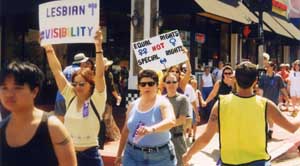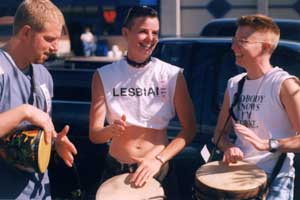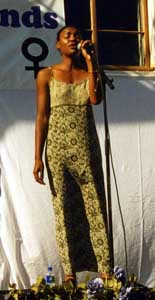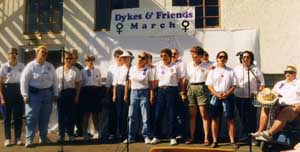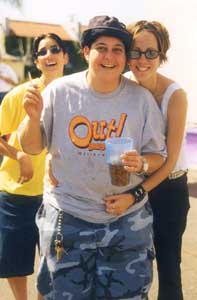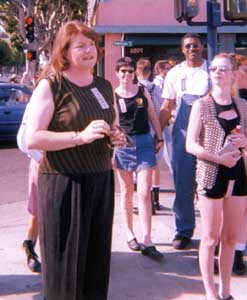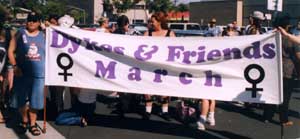-
- Civil unions author lauds California DP bill
- Constitutional marriage amendment debated in U.S. Senate
- Ban predicted in Mass. if high court legalizes gay marriage
- ROTC student loses $40,000 over ‘don’t ask, don’t tell’
- Supreme Court asked to grant custody to lesbians
- Merck testing AIDS vaccine on humans
- Durham first N.C. county to offer same-sex bennies
- University allows antigay web log on school’s server
- National News Briefs
- World News Briefs
feature
When the Dykes … Go Marching On …
San Diego lesbians take to the streets, Sept. 28
Published Thursday, 11-Sep-2003 in issue 820
While the rainbow flags and beaded jewels of Pride have been tucked into their resting places until next year’s event, San Diego lesbians are lacing up their walking shoes for the annual Dyke March, hosted by the Vibrant Activist Grrls Invoking National Attention (VAGINA). The festive event will be held on Sept. 28 at 11:00 a.m., starting at the NBC studios on 4th Ave. and Broadway.
The politically progressive march will conclude with a rally and festivities, as has been tradition, however, this year’s organizers have chosen to alter the mission slightly by changing the date, the location and the make-up of the march itself. For some, this major adjustment has lent itself to controversy, which may or may not affect this year’s turnout.
Rather than march in the comforts of GLBT-safe Hillcrest and the welcoming, tranquil neighborhood of Trolley Barn Park, the gay/bisexual women-centered march will interrupt the hustle and bustle of Sunday’s downtown traffic. Tourists and weekend shoppers will have more than the Star of India to gawk at and photograph — some may even come away educated and enlightened.
“We’ve wanted to go downtown since last year,” said Dru Garcia, former Dyke March facilitator and founding member of VAGINA. “We want to break out of our bubble. We want to make a statement to say we’re politicians, teachers, mothers, daughters. We want people to know we stand up for our rights. We want to be equal, to say we’re here. We’re not only all about vaginas and being with women. We want to say, ‘Respect us, we’re here.’ I would like them (the onlookers of the march) to believe that.”
While rumor has it the Dyke March’s date was moved to the early fall because of a conflict with San Diego Gay and Lesbian Pride (Pride), and a lack of leadership and organization in pulling the march off at the original time designated, organizers claim the change in date was more for political and recruiting reasons. However, organizers do not deny that the change in date was a reflection of a turnover in leadership.
“The gay/bisexual women-centered march will interrupt the hustle and bustle of Sunday’s downtown traffic. Tourists and weekend shoppers will have more than the Star of India to gawk at and photograph….” Heather Flowe, a facilitator from last year’s Dyke March, confirmed that the event had to be rescheduled in part because one of the facilitators moved out of town at the last minute. Because the march was not sufficiently on its way, said Flowe, organizers decided to set the date back to ensure success.
“Changing the date ensured that this year’s organizers would have the resources available to move this event to the new location,” she said.
Abby Schwartz, the current facilitator of the march, said she was optimistic of a good turnout based on the feedback she has received, despite the many changes to this year’s event.
“At first, the location was difficult for some people. There was some hesitancy.… As we increase the visibility of our group and really get the word out, people like the idea of going downtown. I’m just hoping for good weather,” said Schwartz.
Facilitator Laura Sutherland said that the organizers took advantage of the situation to accomplish their goals for this year.
“We wanted to change the date to distance ourselves a little from Pride. We wanted to incorporate the other Prides of the year, like Youth Pride, Ebony Pride and Latin Pride. We wanted to go to those events and get those women involved. We wanted to be one of the last ‘prides’ of the year.”
Aside from instituting a recruiting campaign at the various other San Diego Pride festivities, VAGINA has also decided to slightly alter the mission of the previous marches, which focused on the empowerment of lesbians by hosting a march, rally and festival for, about and by women, to one of attaining assertive visibility in San Diego’s mainstream society.
“We wanted to move out of our comfort zone and move to downtown,” said Sutherland. “You know, we walk in our own neighborhood and have a big party and maybe the people that need to hear our message aren’t… Now we really want to go downtown, and take the message to the people that need to hear it; the message that lesbians are invisible, that women are not heard, that women issues aren’t heard.
“We want to take it downtown and see what’s going to happen,” added Sutherland.
Most of the organizers, themselves a diverse group, agree that visibility is the main goal for this year’s march, but that other issues that affect gay and bisexual women and transgender individuals will also be addressed.
“With some of the surplus funds raised last year, VAGINA donated money and food vouchers to fund battered women’s programs.” The goal of the Dyke March is “to promote dyke visibility and to unite the dyke community,” said organizer Sarah Lawless, which is in tune with most of the organizers’ outlook on the Sept. 28 march.
“What’s so great about this year’s dyke march,” said organizer Armenui Avakian, “is to get to hold an event in a place where 95 percent of the people that are watching us are straights.” Avakian said she felt a change in venue might bring a new awareness to lesbian issues.
“The decision to go downtown is monumental. We will really march with dykes where it matters,” she said. “This year we’re really trying to have this event be about visibility … to make them (spectators) aware of statistics on such things as hate crimes and death; things that will really strike a chord and make the mainstream society understand that we are deprived of basic human rights.”
The organizers hope to accomplish this by forcing the police to close the streets because of the sheer number of marchers, which will in turn attract curious bystanders to the festivities and rally. As it stands, the marchers have no permit to march in the streets and are required to march on the sidewalk. If the march is too big to be contained on the sidewalk, the police may have to accommodate the crowd, said Sutherland. This in turn reflects one of this year’s biggest goals as a Dyke March.
The march will act more as a protest than a parade, according to organizers.
It’s not about parading. We want to separate ourselves from Pride. We want to make it about activism. The main focus is that we’re marching,” said Avakian.
When asked what promotional efforts have been made to attract such a crowd, organizers said they were passing out fliers and involving the gay media. They said they have attempted advertising in the mainstream papers, but have seen no result. They have not intentionally involved other GLBT organizations in the planning or promotion of the event, but say they are confident that many will support the march.
Within the rally and festival, the organizers hope to break stereotypes of lesbians, transgender individuals and bisexual women. The organizers are hopeful and optimistic that passersby will be curious enough to drop in and speculate.
“The main thing to focus on with this year’s Dyke March is visibility,” said Schwartz. “It’s the first year we’ll be downtown. It creates an opportunity for us to be visible to people in San Diego that wouldn’t necessarily see us unless we march downtown. We’ll be able to educate not just the GLBT community, but the straight community.”
“This year we’re taking things to the next level,” she added. “We also want people to walk away from the day with the vision of how they can make a difference within the community.”
“We want to break out of our bubble. We want to make a statement to say we’re politicians, teachers, mothers, daughters…. We’re not only all about vaginas and being with women. We want to say, ‘Respect us, we’re here.’” — Dru Garcia, organizer Other than attempting to attract non-GLBT community members to the rally, VAGINA also hopes to attract a large diversity of participants of various cultural, ethnic and language backgrounds, from young to old. One of VAGINA’s ongoing missions is to ensure that all lesbians, bisexuals and transgender individuals are represented and accounted for.
“Being a dyke doesn’t mean being one type of person,” said Avakian.
Garcia added, “We work really hard to accommodate everyone. It’s not just for a certain age group or a type of dyke. It’s for everyone. It’s great to see a lot of different cultures unite for one event.”
Sutherland said that women will be marching for several reasons this year, whether for visibility, to demand better healthcare, to empower younger lesbians to come out of the closet, to encourage people to be out at work and to feel safe, to demand equal and fair access to housing, and/or to empower women to “do what they want to do.”
“VAGINA’s mission means to help women in the community find healthcare that they couldn’t find before…. It is also there to empower women so they can help other people. It’s really a big sisterhood. Dyke march is a good vehicle to spread that message,” said Sutherland.
Garcia said she believes the efforts of VAGINA and the outreach of Dyke March and the VAGINA-fest have acted as a catalyst to encourage San Diego’s lesbian community to become more unified and visible on a personal basis. Through the years she has noticed a surge of activist endeavors, with different poets, artists and different organizations stepping into the limelight. She believes the overall spirit of VAGINA has acted as a community network to achieve a mission of solidarity in the community.
“Most importantly VAGINA is meant to empower women such as myself. You know you come to a new city, alone, you’re a dyke — you want to make an impact on the community…. VAGINA is about bringing women together, putting our heart into it and getting our shit done,” Garcia said.
Funds raised by the Dyke March have gone to fund the Dyke March and VAGINA-fest for such things as entertainment and pap smears, and have also contributed to other organizations. For example, with some of the surplus funds raised last year, VAGINA donated money and food vouchers to fund battered women’s programs such as those offered at Bienestar, San Diego’s GLBT Latino/a center, and Project SafeHouse. Continuing efforts will be made to raise surplus funds in order to make a charitable donation to an underrepresented organization, said Garcia.
For many, Dyke March is about being part of a bigger movement toward unity, solidarity and equal rights.
“My favorite thing is to be standing in the front lines and turn around and see all these amazing women behind me with unity, empowerment and aggression, like ‘We’re here and we’re going to kick some ass!’” said Garcia.
“My personal observation is that the largest issue facing lesbians and bi-women is the danger of becoming complacent about the rights we’ve gained, the risk of assuming these rights will continue to grow, and the chance that all our gains can still be taken away.” — Tryce Czyczynska, organizer “To see all these amazing women marching with us, bringing all of these women together for one day and for one reason is just absolutely beautiful,” exclaimed Garcia, with noticeable emotion.
Tryce Czyczynska, former Dyke March facilitator and columnist for the Update, said she continues to support the efforts of the Dyke March because of the power a woman-centered event can generate.
“Besides the politically aware and inspiring speakers, like Leslie Feinberg who spotlights this year, my favorite aspect of any Dyke March is sharing a huge venue with countless conscious women who all love women! Although I’m an inclusive activist when it comes to joining the equal rights gain for all, there is an undeniable empowerment that occurs when women share space to celebrate and move forward,” she said.
Organizers are optimistic that they will reach a crowd of 1,000. If the idea of marching down the street under the supervision of police officers is not appealing, the Dyke March rally line-up just may be. With such big name attractions as transgender activist Leslie Feinberg and slam poet Alix Olson, gathering a large crowd should be effortless.
Other than date and venue change, the Dyke March may be losing out on a number of marchers because of another policy change implemented by this year’s leadership. Still, others that refused to march before may find the inclusiveness of this year’s event more to their liking. The past two years, the Dyke March has been a women-only march, with male supporters on the sidelines and an integrated crowd at the rally and festival.
However, this year men will be invited to march alongside their lesbian sisters. According to the organizers, because of the commitment and dedication of several men in the community in regards to supporting lesbian issues, the march will show an integrated effort.
“When it first got started, there were other dyke marches that were really feminist/separatist. It’s really evolved from that,” said Sutherland of integrating the march. According to Sutherland, not all members of VAGINA or the Dyke March are happy about the change, but Sutherland said that she believes the move is part of the social evolution of the movement.
“I’m one of the older dykes and was around during the AIDS crisis. I remember going to the boy’s houses and holding their hands as they were dying,” she said. “There are guys doing a lot of work (for VAGINA), they volunteer and help raise money for domestic violence issues and women issues. They’re really there and that means more to me than I can say. It means a lot to me. I like having that solidarity with them.”
Sutherland said she believes there will be some controversy over her statement about integrating men into the march and there may even be some who refuse to march because of it.
She said, “The women that are separatists don’t come to our meetings. They’re not doing the work. They (the male volunteers) put their money where their mouth is.”
“This year, men will be invited to march alongside their lesbian sisters.” As for those who disagree with the decision, Sutherland said, “They’re welcome to not march, if that’s how they feel….”
Garcia said she has mixed feelings about inviting men to march this year. “The reason is because we lost a lot of people because we didn’t want the boys to march last year. Our goal at that time was to educate them (the men). We wanted the women to feel comfortable marching. This year it’s imperative we have boys because we don’t know what the turnout will be. A lot of them won’t march (out of respect) and I’m still pushing for them to make a blanket statement,” said Garcia.
The Blanket Statement was a campaign generated by the first VAGINA Dyke March to include men in the fundraising and activist aspects of the march and rally. Men were asked to create blankets with slogans in support of the dykes and stand along the route of the march in support. This would help to attract innocent bystanders and would help foster unity between men and women within the gay civil rights movement. Men have fully participated in the Blanket Statement campaign and in the organizing and fundraising of the Dyke March the last few years and are still encouraged to do so.
“This isn’t a party-fest like other events. This is for the women still and they (men) should be out there to support this. I don’t want the boys to forget that. This is more political. Support your ‘chicks.’ Hold your signs up and support us,” said Garcia.
She said that whether or not men march alongside women is not as important as recognizing that this day is for and about women.
In the upcoming months, VAGINA, will host the annual VAGINA-fest, a free health care festival to provide safe and compassionate lesbian and transgender friendly pap and mammogram screening, with entertainment in the background. Its mission is to provide access to gynecological healthcare, which many lesbians and female to male transgender individuals avoid out of discrimination or ignorance.
In addition, VAGINA and The Center have founded the Women’s Resource Room at The Center. Organizers are currently working to get the facility up and running. The Resource Center will be available as a meeting place and resource center, run by volunteers on a grass root level to provide information, access and support to those who seek assistance.
*To become involved with VAGINA, Dyke March or the VAGINA-fest, email dykes_2001@hotmail.com or call Sue Byrd at (619) 312-3206. The Women Resource Center’s information line can be reached by calling The Center at (619) 692-2077, ext 206. While it seems the Dyke March has made only a slight dent in San Diego’s history because of its constant fluctuation of facilitators, agendas and venues, it is actually part of a rich and complex movement that has spread nationwide for nearly 30 years. Where did the Dyke March come from and why are women still marching?
During the feminist movement of the 1970s, gay and bisexual women began to analyze their role and visibility in the gay community. Many believed that the umbrella term “gay movement” was not inclusive of women.
Because of this, many demanded the term “lesbian” be used when referring to gay and bisexual women. The 1980s showed a reflection of this trend when organizations and committees began using the term in their acronyms. This new visibility helped women to have a more tangible concept of women-centered issues. A momentum for lesbian- and women-centered rallies began popping up across the nation to increase visibility and raise awareness about sexism within the gay community.
For example, San Diego witnessed a couple thousand women marching through the Embarcadero during the NOW Lesbian Rights Conference held here in the 1980s.
The drive for lesbian marches ebbed and flowed but was rekindled during the 1993 March On Washington, when 20,000 women marched through the capitol to demand rights for lesbians. Similar events, attracting substantial numbers of women, began popping up all over the country and spread internationally as well. The Lesbian Avengers organization planned and implemented marches in major cities such as New York and San Francisco to give voice to those who were often drowned out or overshadowed by the attention given to male homosexuals. These women took over the streets without obtaining permits and often removed their shirts in protest of sexist laws that prevent women from roaming topless. The marches were extremely political and grew strength in numbers from the growing feminist movement and sexual revolution.
Although San Diego’s numbers never reached the 20,000 turnout of D.C., for several years thousands of women have turned out to march for lesbian and bisexual women’s rights in America’s Finest City.
After 1994, the Dyke March momentum slowed and fewer lesbians came out to march in San Diego. The idea of a march lay dormant for several years until 1999, when Tryce Czyczynska along with Wendy Sue Biegeleisen and several members of a leather organization in which she was involved, decided to take matters into their own hands. Biegleisen said they realized nobody else was going to organize dyke marches in San Diego, so they’d do it themselves. She, along with Czyczynska, organized the “Dykes and Friends March” for two years. This march started at Balboa Park and finished in The Center’s parking lot. A political rally and entertainment were provided.
In 2001, Sherry Wright and Terese Farmen founded the Vibrant Activist Grrls Invoking National Attention (VAGINA) organization and headed up that year’s Dyke March. A record-breaking 1,000 women marched that year and several supporters were witness to an extensive festival and rally at Trolley Barn Park.
The following year, Heather Flowe and Dru Garcia took up the reigns of both VAGINA and Dyke March, facilitating an event that nearly doubled its participants from the previous year. VAGINA received awards from such organizations as the Imperial Court de San Diego and San Diego Pride for its activism and dedication to lesbian issues.
This year, the venue will return to the Embarcadero Park, 23 years later, with Abby Schultz and Laura Sutherland in the facilitator role.
Why do women continue to march despite changing political climates, ideologies and commitment to activism?
Czyczynska, who is not affiliated with VAGINA, but continues to be a supporter and volunteer for Dyke March, said, “My personal observation is that the largest issue facing lesbians and bi-women is the danger of becoming complacent about the rights we’ve gained, the risk of assuming these rights will continue to grow, and the chance that all our gains can still be taken away.”
For her, marching lends itself to consistency within the movement because, she says, many dykes are too eager for immediate change and burn out rather easily. A movement takes longer than a year to accomplish great feats.
“How I’ve seen the issues facing dykes today change is that fewer women seem to fully understand that true change takes many years. Those women who understand this are expending more energy than they can afford in order to make up for the lack of numbers,” she said. “The result is that too many of our women activists get burned out after only a couple years. This is hardly enough time to learn how to be an effective activist and certainly not enough time to turn that knowledge around in order to mentor our up-and-coming ‘grrl’ activists. The result is that many of our newer movers-and-shakers are having to learn with little support.”
Wright, who is now a senior field organizer with the National Gay and Lesbian Task Force in Los Angeles, said that politically, dyke marches are a tool to gain leverage in understanding the complexity of oppression and how it affects an individual on a personal basis. It is essentially a great tool of education.
“I think it’s important for dykes to be visible because, first of all, we’re not. If you look around the community, it is still male-driven as most of the money is made and spent by men. In order for us to build any kind of power or build community around lesbian issues, we need to be visible to show other women that not only are we here, but we’re doing great things.”
While it seems that lesbians and bisexual women are in a constant flux about what the important issues are in a given year, whether it’s lesbian and transgender health care, domestic violence, the murder of community members, whether or not men should march, or whether or not the word “dyke” is appropriate, there is something extremely rewarding and empowering in seeing the gift of activism passed from hand to hand, march to march.
“It may seem that dykes have more rights today, with changing ideologies and legislation, but the truth is, homophobia and sexism are still rampant,” says former Dyke March facilitator Heather Flowe. “It is essential that women show themselves in numbers to empower others to speak out.”
No matter what one’s politics or values may be, and whether or not one supports, organizes, participates or boycotts it, the Dyke March will continue to make history as a political movement, and provide structure for a fractured community with an oft-silent voice.
|
|
Copyright © 2003-2025 Uptown Publications

